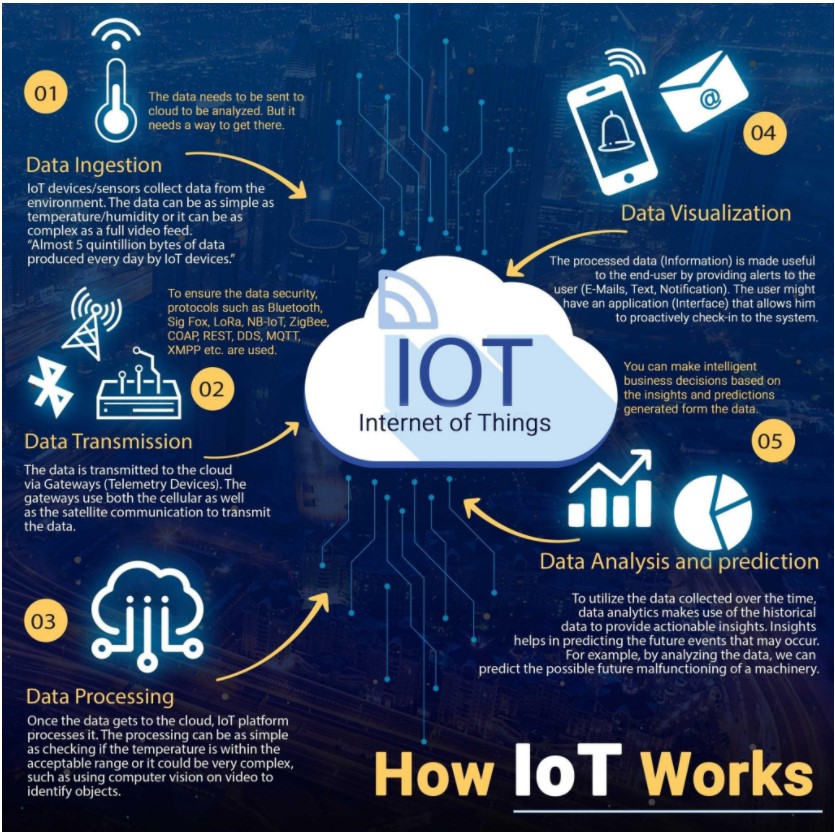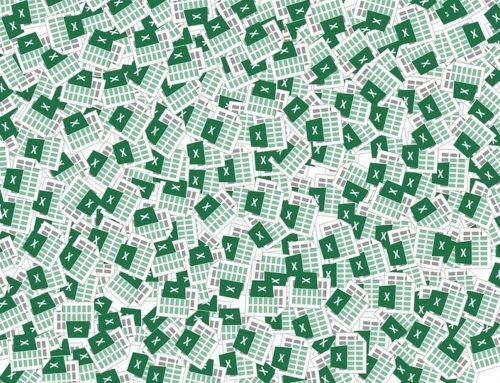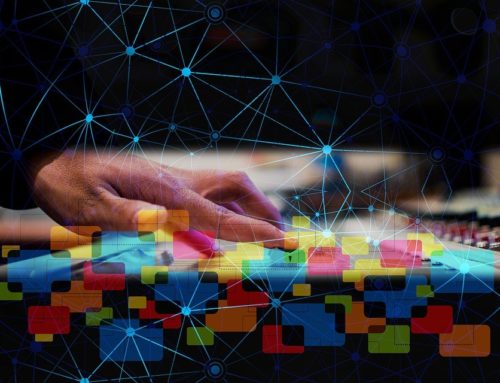Over the past few years, IoT has become one of the most important technologies of the 21st century. Now that we can connect everyday objects – kitchen appliances, cars, thermostats, baby monitors – to the internet via embedded devices, seamless communication is possible between people, processes, and things.
By means of low-cost computing, the cloud, big data, analytics, and mobile technologies, physical things can share and collect data with minimal human intervention. In this hyperconnected world, digital systems can record, monitor, and adjust each interaction between connected things.
The physical world meets the digital world – and they cooperate.

What is the Internet of Things?
The Internet of Things, or IoT, refers to the billions of physical devices around the world that are now connected to the internet, all collecting and sharing data. Thanks to the arrival of super-cheap computer chips and the ubiquity of wireless networks, it’s possible to turn anything, from something as small as a pill to something as big as an aircraft, into a part of the IoT.
Connecting up all these different objects and adding sensors to them adds a level of digital intelligence to devices that would be otherwise dumb, enabling them to communicate real-time data without involving a human being. The Internet of Things is making the fabric of the world around us more smarter and more responsive, merging the digital and physical universes.
What is an example of an Internet of Things Device?
Pretty much any physical object can be transformed into an IoT device if it can be connected to the internet to be controlled or communicate information.
A light bulb that can be switched on using a smartphone app is an IoT device, as is a motion sensor or a smart thermostat in your office or a connected streetlight. An IoT device could be as fluffy as a child’s toy or as serious as a driverless truck.
The term IoT is mainly used for devices that wouldn’t usually be generally expected to have an internet connection, and that can communicate with the network independently of human action
How big is the Internet of Things?
Big and getting bigger – there are already more connected things than people in the world.
Almost 5 quintillion bytes of data are produced everyday by IoT devices.
Tech analyst company IDC predicts that in total there will be 41.6 billion connected IoT devices by 2025, or “things.” It also suggests industrial and automotive equipment represent the largest opportunity of connected “things,”, but it also sees strong adoption of smart home and wearable devices in the near term.
Another tech analyst, Gartner, predicts that the enterprise and automotive sectors will account for 5.8 billion devices this year, up almost a quarter on 2019.
Utilities will be the highest user of IoT, thanks to the continuing rollout of smart meters. Security devices, in the form of intruder detection and web cameras will be the second biggest use of IoT devices. Building automation – like connected lighting – will be the fastest growing sector, followed by automotive (connected cars) and healthcare (monitoring of chronic conditions).

How IoT Works
Data Ingestion
IoT devices/sensors collect data from the environment. The data can be as simple as temperature/humidity or it can be as complex as a full video feed.
The data needs to be sent to the cloud to be analyzed. But it needs a way to get there.
Data Transmission
The data is transmitted to the cloud via Gateways (Telemetry Devices). The gateways use both the cellular as well as the satellite communication to transmit the data.
To ensure data security, protocols such as Bluetooth, Sig Fox, LoRa, NB-IoT, ZigBee, COAP, REST, DDS, MQIT, XMPP, etc. are used.
Data Processing
Once the data gets to the cloud, IoT platform processes it.
The processing can be as simple as checking if the temperature is within the acceptable range or it could be very complex, such as using computer vision on the video to identify objects.
Data Visualization
The processed data (Information) is made to the end-user by providing alerts to the user (E-Mails, text, notification).
The user might have an application (interface) that allows him to proactively check-in to the system.
Data Analysis and Prediction
To utilize the data collected over the time, data analytics makes use of the historical data to provide actionable insights.
Insights help in predicting future events that may occur. You can make intelligent business decisions based on the insights and predictions generated from the data.

Benefits of IoT for Business
As IoT becomes more widespread in the marketplace, companies are capitalizing on the tremendous business value it can offer. These benefits include:
Cost Reduction
From cybersecurity to workplace efficiency, IoT devices are already making an impact on companies’ bottom lines. Maintenance costs can be positively impacted when IoT devices are used with sensors to keep business equipment running at peak efficiency.
On-the-fly troubleshooting of office equipment encountering problems before they impact staff and employees, saving the hassle and costs of large repairs. This minimizes costly extended downtime for repairs – just one of the benefits the Internet of Things brings to your operations and maintenance workflow.
Efficiency and Productivity
Efficiency is the basis for the kind of improved productivity that boosts revenue for businesses. One way to leverage the power of IoT to increase company efficiency is to use it to cut down on repetitive or time-consuming tasks.
In the work environment, IoT can be used to optimize an office floor plan and mobilize company resources – like copiers, printers, and Wi-Fi bandwidth – for a better workflow and a more streamlined and effective approach to management.
Finally, using big data analytics through IoT can provide an overview of employee productivity and help determine what tasks are improving the function of your business – and which are impairing it.
Big data can also be instrumental in tracking efficiency for manufacturing supply chains. Businesses can follow delivery systems and monitor products and inventory to stay ahead of demand.
Business Opportunities
While many businesses strive to access the revenue-producing power of digital services, most lack a cohesive strategy for pursuing this avenue. IoT is a game-changer in this respect, as advanced analytics, artificial intelligence, and smart utility grids make it easy for businesses to collect actionable data needed to provide the value their customers are seeking.
These analytics provide new insights that are not only being utilized to create new business models, but completely redefining traditional industries.
For example, IoT sensors on automobiles that can track speed and driving habits help insurers optimize rates on automobile insurance. Retailers can use IoT to measure in-store foot traffic to optimize displays for maximum impact based on customer habits.
As a result of IoT’s ability to connect products and services as they relate to customer behaviors, more businesses are delivering new or updated products and services to an expanded customer base.
With more data available through IoT devices than ever before on customer preferences and product performance over time, businesses are able to use this and predict behavior patterns and needs of consumers better than ever.
Customer Experience
While IoT technology has so far mostly influenced back-end processes because of its relatively new presence, today’s IoT has meant that omni-channel strategies have completely upended the way consumers approach their relationships with businesses.
Front-end customer engagement has become a priority for organizations as they look to engage better with their audiences, usually through IoT devices. Customers in 2020 have an expectation towards businesses that must be met; namely that they want to be able to interact with you through their phone, whether that’s using an automated chatbot or dedicated app.
Because of this, forward-thinking businesses are using new technology and combining it with the IoT to better serve their customers.
Mobility and Agility
The nature of IoT technology means that businesses now have the opportunity to let their employees conduct their work from virtually any location – flexibility that can provide key advantages to businesses during the current pandemic times.
Office leases aren’t cheap, and the IoT revolution has allowed a surge in small and mid-sized businesses changing the way they operate – hiring more full-time remote employees in “work from anywhere” positions.
Organizations have had to create remote work policies in order to meet these new demands. Remote workers will become an integral part of modern workforces, and that appears to be something that is here to stay.
Utilizing IoT technology across all your devices for communication purposes, as well as using a solid strategy for securing those endpoints, will be primary concerns for any initiatives making use of the benefits of the Internet of Things.

What Industries can benefit from IoT
Organizations best suited for IoT are those that would benefit from using sensor devices in their business processes.
Manufacturing
Manufacturers can gain a competitive advantage by using production-line monitoring to enable proactive maintenance on equipment when sensors detect an impending failure. Sensors can actually measure when production output is compromised.
With the help of sensor alerts, manufacturers can quickly check equipment for accuracy or remove it from production until it is repaired. This allows companies to reduce operating costs, get better uptime, and improve asset performance management.
Automotive
The automotive industry stands to realize significant advantages from the use of IoT applications. In addition to the benefits of applying IoT to production lines, sensors can detect impending equipment failure in vehicles already on the road and can alert the driver with details and recommendations.
Thanks to aggregated information gathered by IoT-based applications, automotive manufacturers and suppliers can learn more about how to keep cars running and car owners informed.
Transportation and Logistics
Transportation and logistical systems benefit from a variety of IoT applications. Fleets of cars, trucks, ships, and trains that carry inventory can be rerouted based on weather conditions, vehicle availability, or driver availability, thanks to IoT sensor data.
The inventory itself could also be equipped with sensors for track-and-trace and temperature-control monitoring. The food and beverage, flower, and pharmaceutical industries often carry temperature-sensitive inventory that would benefit greatly from IoT monitoring applications that send alerts when temperatures rise or fall to a level that threatens the product.
Retail
IoT applications allow retail companies to manage inventory, improve customer experience, optimize supply chain, and reduce operational costs.
For example, smart shelves fitted with weight sensors can collect RFID-based information and send the data to the IoT platform to automatically monitor inventory and trigger alerts if items are running low. Beacons can push targeted offers and promotions to customers to provide an engaging experience.
Public Sector
The benefits of IoT in the public sector and other service-related environments are similarly wide-ranging.
For example, government-owned utilities can use IoT-based applications to notify their users of mass outages and even of smaller interruptions of water, power, or sewer services. IoT applications can collect data concerning the scope of an outage and deploy resources to help utilities recover from outages with greater speed.
Healthcare
IoT asset monitoring provides multiple benefits to the healthcare industry.
Doctors, nurses, and orderlies often need to know the exact location of patient-assistance assets such as wheelchairs. When a hospital’s wheelchairs are equipped with IoT sensors, they can be tracked from the IoT asset-monitoring application so that anyone looking for one can quickly find the nearest available wheelchair.
Many hospital assets can be tracked this way to ensure proper usage as well as financial accounting for the physical assets in each department.
Insurance
IoT technology can become an opportunity for insurers as a simple, effective tool for home management to prevent or lessen common forms of damage like water or fire.
Simple sensor implementation can give homeowners and renters contextual information about the conditions of the property related to water, fire, smoke, carbon monoxide, open doors or windows, humidity, room occupancy, temperature and more.
Consumers can use this information to proactively monitor their property for damage. Consider water, the leading causes for claims. The smart home can disrupt this damage.
A water detector can send homeowners a push notification if moisture is detected. Placed in key, at-risk areas of the home, such as under sinks, behind washing machines and in the basement, a water sensor makes it easy for a homeowner to investigate a situation and mitigate damage. Instead of arriving home to a kitchen flooded from a leaky pipe, a notification of water detected could send an owner home earlier to find and address a small puddle before it becomes more problematic damage.
Banking
The increased usage of devices by bank customers had resulted in an increase in the usage of IoT data. Banks are now using IoT data to be able to transform the experiences of their customers and offer customized services and products.
It provides rewarding, easy-to-access services not only to debit but also credit card customers. The banks are able to analyze how customers use ATM kiosks in various areas and reduce or increase the installation of ATMs in those areas depending on the volumes of usage.
Besides, banks can also utilize IoT to bring in on-demand services nearer the customers by installing kiosks and increasing the accessibility of banking services to the customers. IoT offers customer data that helps banks identify the business needs of their customers, their value chain for example retailers, suppliers, and distributors.
The data also helps banks to gain customer insights. The information about customers that is available through IoT helps banks to provide value-added services, customized banking services and products, and financial assistance to ensure there is a win-win situation for the parties involved – the customer and the bank.
Real Estate
IoT is a technology where systems such as plumbing, electrical outlets, thermostats and lighting are connected and perform smart functions via the internet. From convenient property showing and increased energy efficiency to predictive maintenance, IoT applications are making it easier for people to buy, sell and own rental properties.
Smart homes with IoT capabilities usually have a higher market value than those that don’t.
General Safety across all Industries
In addition to tracking physical assets, IoT can be used to improve worker safety.
Employees in hazardous environments such as mines, oil and gas fields, and chemical and power plants, for example, need to know about the occurrence of a hazardous event that might affect them.
When they are connected to IoT sensor–based applications, they can be notified of accidents or rescued from them as swiftly as possible. IoT applications are also used for wearables that can monitor human health and environmental conditions.
Not only do these types of applications help people better understand their own health, they also permit physicians to monitor patients remotely.
Is IoT a game changer for your Business?
Take Connected Cars as an Example

IoT is reinventing the automobile by enabling connected cars. With IoT, car owners can operate their cars remotely, for example, turning on the air-conditioner before the driver gets in it or by remotely summoning a car by phone. Given IoT’s ability to enable device-to-device communication, cars will even be able to book their own service appointments when warranted.
The connected car allows car manufacturers or dealers to turn the car ownership model on its head. Previously, manufacturers have had an arms-length relationship with individual buyers (or none at all). Essentially, the manufacturer’s relationship with the car ended once it was sent to the dealer.
With connected cars, automobile makers or dealers can have a continuous relationship with their customers. Instead of selling cars, they can charge drivers usage fees, offering a “transportation-as-a-service” using autonomous cars.
IoT allows manufacturers to upgrade their cars continuously with new software, a sea-change difference from the traditional model of car ownership in which vehicles immediately depreciate in performance and value.
With an IoT platform, you can extend your supply chain, ERP, HR, and customer experience (CX) applications to the digital world. Leverage intelligent, predictive algorithms and digital twins to improve operational efficiency, boost worker productivity, enhance CX, and create new business models and opportunities.
Do let us know in case if you face any concerns with regards to asset tracking, employee safety, inventory tracking/replenishments etc. and we can assist you with establishing a clear investment strategy on the IoT front.
Author



